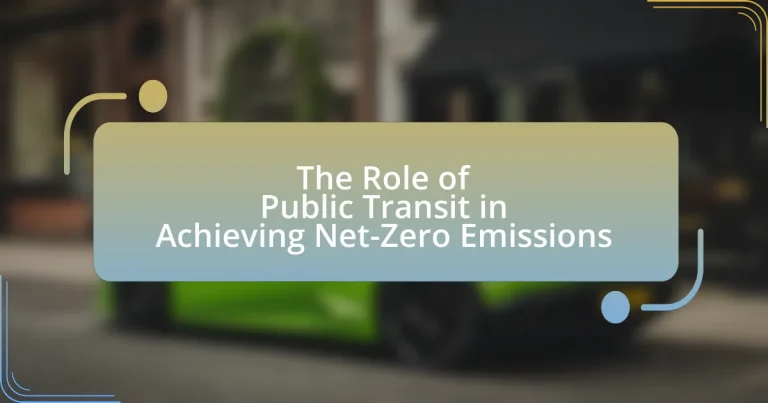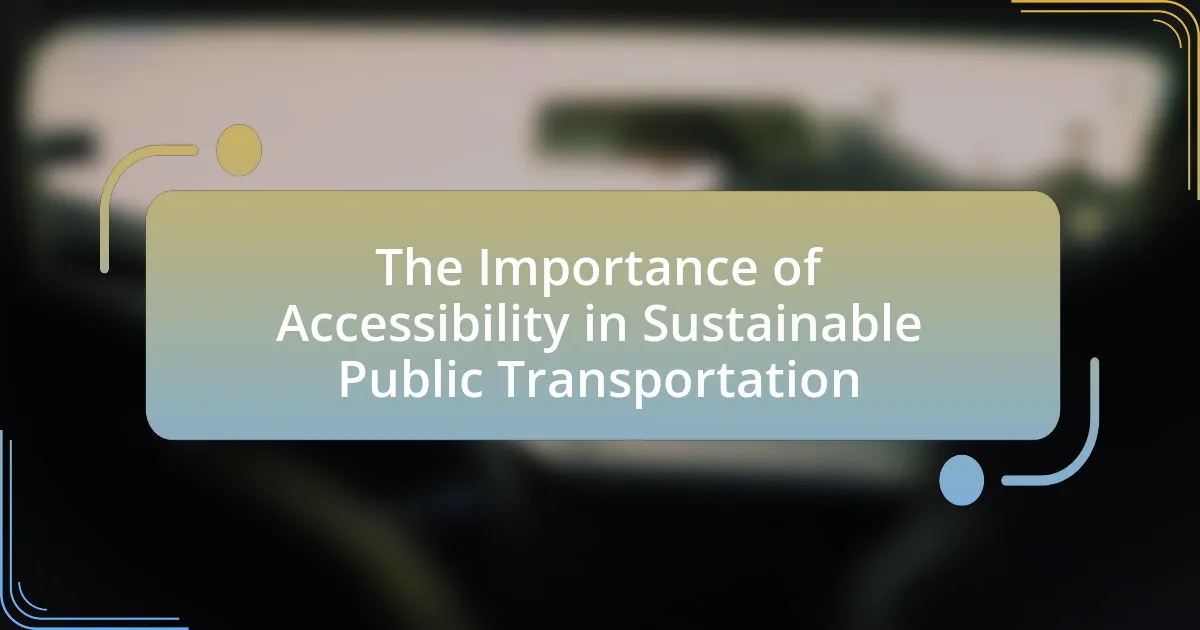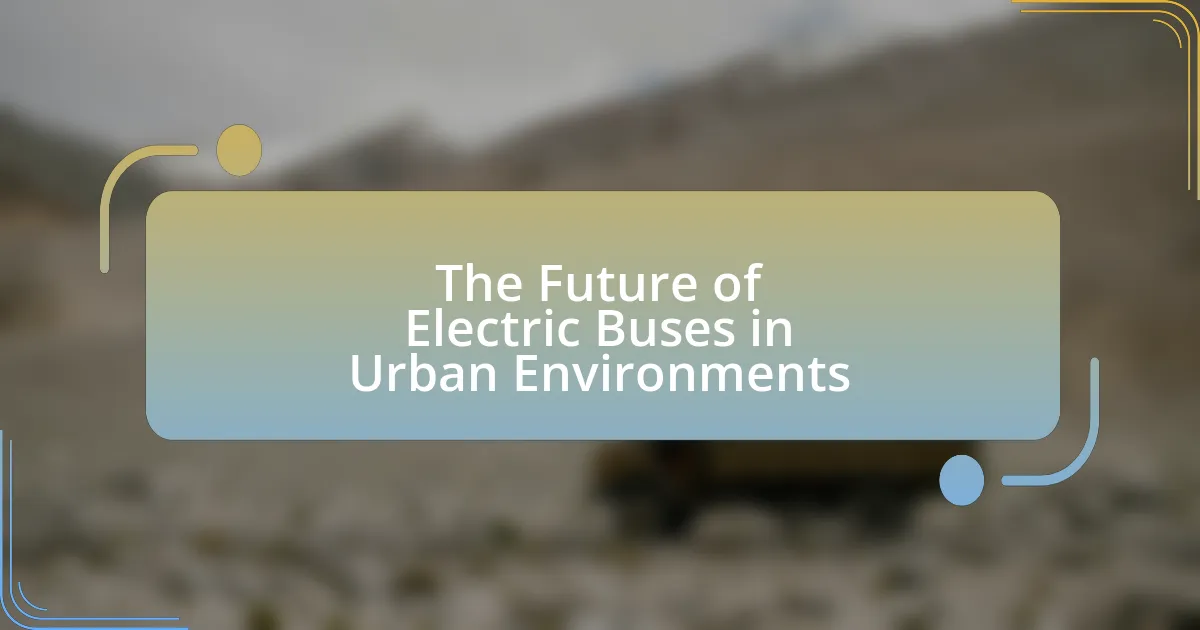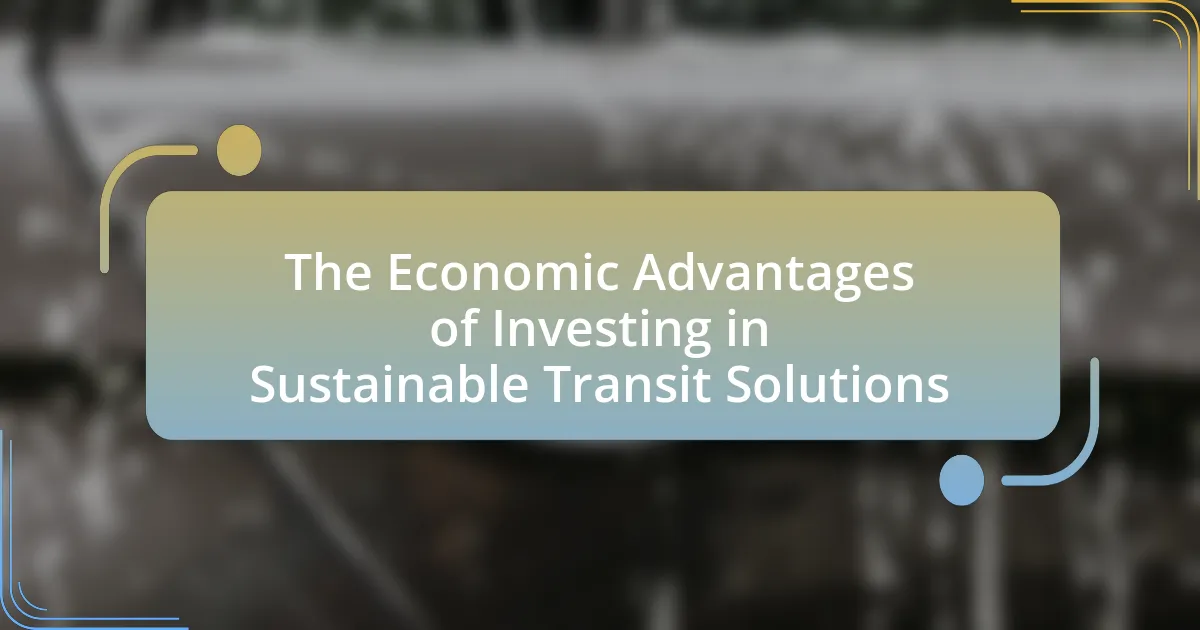Public transit is a vital component in the effort to achieve net-zero emissions, significantly reducing greenhouse gas emissions per passenger mile compared to private vehicles. The American Public Transportation Association highlights that public transit can lower individual carbon footprints by up to 45% in urban areas, saving approximately 45 million metric tons of carbon dioxide annually. This article explores how public transit contributes to emissions reduction through increased passenger capacity, energy-efficient technologies, and its role in sustainable urban development. It also addresses the challenges faced by public transit systems, including outdated infrastructure and funding limitations, while outlining best practices and successful case studies that demonstrate effective strategies for enhancing public transit’s impact on climate change.

What is the Role of Public Transit in Achieving Net-Zero Emissions?
Public transit plays a crucial role in achieving net-zero emissions by significantly reducing greenhouse gas emissions per passenger mile compared to private vehicles. According to the American Public Transportation Association, public transit can reduce individual carbon footprints by up to 45% in urban areas. By providing efficient, high-capacity transportation options, public transit systems decrease reliance on fossil fuel-powered personal vehicles, thereby lowering overall emissions. Additionally, investments in electric and hybrid public transit vehicles further enhance this impact, contributing to cleaner air and sustainable urban development.
How does public transit contribute to reducing greenhouse gas emissions?
Public transit significantly reduces greenhouse gas emissions by providing a more efficient alternative to individual car travel. Buses, trains, and subways can transport many passengers simultaneously, leading to lower per capita emissions. For instance, the American Public Transportation Association reports that public transit saves approximately 45 million metric tons of carbon dioxide annually, equivalent to the emissions from 9.5 million cars. This efficiency stems from reduced traffic congestion and the potential for using cleaner energy sources in transit systems, further decreasing overall emissions.
What are the key mechanisms through which public transit reduces emissions?
Public transit reduces emissions primarily through increased passenger capacity, which leads to fewer vehicles on the road. By transporting multiple passengers simultaneously, public transit systems like buses and trains significantly decrease the number of individual car trips, thereby lowering overall greenhouse gas emissions. For instance, the American Public Transportation Association reports that public transit saves approximately 45 million metric tons of carbon dioxide annually, equivalent to the emissions from 9.5 million cars. Additionally, public transit often utilizes more energy-efficient vehicles and can be integrated with renewable energy sources, further minimizing its carbon footprint.
How does the efficiency of public transit compare to private vehicles?
Public transit is generally more efficient than private vehicles in terms of energy consumption and emissions per passenger mile. Studies indicate that public transit systems can reduce greenhouse gas emissions by up to 45% compared to private vehicles, primarily due to higher occupancy rates and lower per capita energy use. For instance, the American Public Transportation Association reports that public transit saves approximately 4.2 billion gallons of gasoline annually, which translates to a significant reduction in overall fuel consumption and emissions.
Why is public transit essential for sustainable urban development?
Public transit is essential for sustainable urban development because it significantly reduces greenhouse gas emissions and traffic congestion. By providing an efficient alternative to private vehicle use, public transit systems can lower the carbon footprint of urban areas. For instance, according to the American Public Transportation Association, public transit saves approximately 45 million metric tons of carbon dioxide annually, equivalent to the emissions from over 9 million cars. This reduction in emissions is crucial for cities aiming to achieve net-zero targets and improve air quality, making public transit a vital component of sustainable urban planning.
What are the environmental benefits of integrating public transit into urban planning?
Integrating public transit into urban planning significantly reduces greenhouse gas emissions and air pollution. Public transit systems, such as buses and trains, can transport a larger number of people compared to individual vehicles, leading to fewer cars on the road. According to the American Public Transportation Association, public transit use saves approximately 45 million metric tons of carbon dioxide annually, which is equivalent to the emissions from 9.5 million cars. Additionally, enhanced public transit reduces reliance on fossil fuels, promoting cleaner energy sources and contributing to improved urban air quality. This integration also encourages sustainable land use, which can further minimize environmental impacts by preserving green spaces and reducing urban sprawl.
How does public transit influence land use and community design?
Public transit significantly influences land use and community design by promoting higher density development and mixed-use areas. This is evidenced by studies showing that areas with robust public transit systems tend to have more compact, walkable neighborhoods, which reduces reliance on personal vehicles. For instance, research from the American Public Transportation Association indicates that communities near transit stations experience a 20% increase in property values, leading to more investment in local infrastructure and amenities. Additionally, public transit encourages the development of affordable housing options, as seen in cities like Portland, where transit-oriented development policies have resulted in a 30% increase in affordable housing near transit lines. This integration of public transit into land use planning fosters sustainable urban growth and contributes to achieving net-zero emissions by reducing greenhouse gas emissions associated with transportation.
What challenges does public transit face in achieving net-zero emissions?
Public transit faces significant challenges in achieving net-zero emissions, primarily due to outdated infrastructure, reliance on fossil fuels, and funding limitations. Many transit systems operate with aging vehicles that are not equipped for electrification, which hinders the transition to cleaner technologies. Additionally, a substantial portion of public transit fleets still relies on diesel and gasoline, contributing to greenhouse gas emissions. Financial constraints further complicate the situation, as many transit agencies struggle to secure the necessary funding for upgrades and investments in sustainable technologies. According to the American Public Transportation Association, public transit systems need an estimated $90 billion over the next decade to modernize and reduce emissions effectively.
What are the financial and political barriers to expanding public transit systems?
Financial barriers to expanding public transit systems include high capital costs, ongoing operational expenses, and funding limitations. For instance, the construction of new transit infrastructure often requires significant upfront investment, which can strain municipal budgets. Political barriers involve lack of political will, competing priorities, and public opposition. Research indicates that political leaders may prioritize short-term projects over long-term transit investments due to immediate voter concerns, as seen in various urban areas where public transit funding has been deprioritized in favor of road expansions.
How do technological limitations impact the effectiveness of public transit?
Technological limitations significantly hinder the effectiveness of public transit by restricting operational efficiency, service reliability, and user accessibility. For instance, outdated scheduling systems can lead to longer wait times and inefficient route planning, which discourages ridership. According to a study by the Transportation Research Board, cities with advanced real-time tracking and communication technologies experience a 20% increase in ridership due to improved service reliability. Furthermore, limitations in vehicle technology, such as the lack of electric or hybrid options, can impede efforts to reduce emissions, directly affecting public transit’s role in achieving net-zero goals.
How can public transit systems be improved to enhance their role in emissions reduction?
Public transit systems can be improved to enhance their role in emissions reduction by increasing the adoption of electric and hybrid vehicles, optimizing routes for efficiency, and expanding service coverage. Transitioning to electric buses can reduce greenhouse gas emissions significantly; for instance, electric buses can cut emissions by up to 70% compared to diesel buses. Additionally, implementing smart technology for route optimization can decrease fuel consumption and travel times, leading to lower emissions. Expanding service coverage encourages more people to use public transit instead of personal vehicles, which can further reduce overall emissions. According to the American Public Transportation Association, public transit use can reduce individual carbon footprints by 45% per mile.
What innovative technologies can be adopted by public transit systems?
Public transit systems can adopt innovative technologies such as electric buses, real-time tracking systems, and integrated mobility platforms. Electric buses reduce greenhouse gas emissions significantly, with studies indicating that they can lower emissions by up to 70% compared to diesel buses. Real-time tracking systems enhance operational efficiency and improve user experience, as they provide accurate arrival times and service updates. Integrated mobility platforms facilitate seamless connections between various modes of transport, promoting the use of public transit and reducing reliance on personal vehicles, which is essential for achieving net-zero emissions.
How can policy changes support the growth of sustainable public transit?
Policy changes can support the growth of sustainable public transit by increasing funding for infrastructure, incentivizing the use of clean technologies, and implementing regulations that prioritize public transit over private vehicle use. For instance, cities that allocate a higher percentage of their budgets to public transit infrastructure, such as bus lanes and rail systems, have seen significant increases in ridership and reductions in greenhouse gas emissions. According to a report by the American Public Transportation Association, every $1 invested in public transit generates approximately $4 in economic returns, demonstrating the financial viability of such policy changes. Additionally, policies that promote electric buses and renewable energy sources for transit systems can further reduce emissions, aligning with net-zero goals.

What are the broader impacts of public transit on climate change?
Public transit significantly reduces greenhouse gas emissions, thereby mitigating climate change. By providing an alternative to single-occupancy vehicles, public transit systems lower the overall carbon footprint of urban transportation. For instance, the American Public Transportation Association reports that public transit saves approximately 45 million metric tons of carbon dioxide annually, equivalent to the emissions from 9.5 million cars. Additionally, increased public transit usage can lead to reduced traffic congestion, which further decreases emissions from idling vehicles. Overall, the expansion and enhancement of public transit infrastructure are crucial for achieving net-zero emissions targets.
How does public transit affect overall energy consumption in cities?
Public transit significantly reduces overall energy consumption in cities by providing an efficient alternative to individual car travel. Studies indicate that public transit systems, such as buses and trains, consume less energy per passenger mile compared to private vehicles. For instance, the American Public Transportation Association reports that public transit saves approximately 4.2 billion gallons of gasoline annually, which translates to a reduction of about 37 million metric tons of carbon dioxide emissions. This efficiency is largely due to higher passenger capacity and the use of energy-efficient technologies in transit vehicles. Consequently, cities with robust public transit networks experience lower energy demand and reduced greenhouse gas emissions, contributing to efforts aimed at achieving net-zero emissions.
What role does public transit play in promoting renewable energy use?
Public transit plays a crucial role in promoting renewable energy use by reducing reliance on fossil fuels and increasing the efficiency of energy consumption in urban areas. By providing a mass transportation option, public transit systems can significantly lower greenhouse gas emissions per passenger mile compared to individual car travel. For instance, according to the American Public Transportation Association, public transit saves approximately 45 million metric tons of carbon dioxide annually, which is equivalent to the emissions from 9.5 million cars. This shift not only encourages the use of electric and hybrid buses but also supports the integration of renewable energy sources into the grid, as public transit systems can utilize solar and wind energy for their operations. Thus, public transit is a vital component in the transition towards a sustainable energy future.
How does public transit contribute to reducing urban heat islands?
Public transit contributes to reducing urban heat islands by decreasing the number of individual vehicles on the road, which lowers greenhouse gas emissions and mitigates heat generation from traffic. Studies indicate that increased public transit usage can lead to a significant reduction in urban temperatures; for instance, a report from the American Public Transportation Association found that public transit can reduce carbon emissions by 45 million metric tons annually, which indirectly helps in cooling urban areas. Additionally, public transit systems often incorporate green infrastructure, such as trees and vegetation around transit stations, which further helps to lower surface temperatures and improve air quality.
What social benefits arise from enhanced public transit systems?
Enhanced public transit systems provide significant social benefits, including increased accessibility, reduced traffic congestion, and improved public health. These systems enable individuals, particularly those without private vehicles, to access jobs, education, and essential services, thereby promoting social equity. For instance, a study by the American Public Transportation Association found that public transit reduces traffic congestion by 45 million hours annually, leading to less air pollution and lower stress levels among commuters. Additionally, enhanced public transit contributes to healthier communities by encouraging walking and reducing reliance on cars, which can decrease obesity rates and related health issues.
How does public transit improve accessibility for underserved communities?
Public transit improves accessibility for underserved communities by providing affordable and reliable transportation options that connect individuals to essential services, employment opportunities, and educational institutions. Studies show that areas with robust public transit systems experience increased mobility, which is crucial for low-income populations who may lack access to private vehicles. For instance, the American Public Transportation Association reports that public transit reduces transportation costs by approximately $9,000 per year for a household, enabling residents to allocate resources to other necessities. Furthermore, effective public transit systems can reduce travel times and enhance overall community engagement, fostering economic development and social inclusion.
What is the impact of public transit on public health and well-being?
Public transit positively impacts public health and well-being by reducing air pollution, promoting physical activity, and enhancing social equity. Studies show that increased use of public transit leads to lower emissions of harmful pollutants, which in turn decreases respiratory and cardiovascular diseases. For instance, a report by the American Public Transportation Association indicates that public transit reduces greenhouse gas emissions by 45 million metric tons annually, contributing to cleaner air. Additionally, public transit encourages walking and cycling to and from transit stops, which promotes physical health; research from the Transportation Research Board highlights that individuals who use public transit engage in more physical activity compared to those who rely on private vehicles. Furthermore, public transit enhances access to essential services and employment opportunities, thereby improving social equity and overall community well-being.
How can public transit systems engage communities in sustainability efforts?
Public transit systems can engage communities in sustainability efforts by implementing programs that promote public awareness and participation in eco-friendly initiatives. For instance, transit agencies can organize community workshops and outreach campaigns that educate residents about the environmental benefits of using public transportation, which can reduce greenhouse gas emissions by up to 45% per mile compared to single-occupancy vehicles. Additionally, public transit systems can collaborate with local organizations to develop incentive programs, such as discounts for frequent riders or rewards for using sustainable modes of transport, thereby fostering a culture of sustainability within the community.
What strategies can be used to raise public awareness about the benefits of public transit?
To raise public awareness about the benefits of public transit, targeted educational campaigns can be implemented. These campaigns should highlight the environmental advantages of public transit, such as reduced greenhouse gas emissions, which are crucial for achieving net-zero emissions goals. For instance, studies show that public transit can reduce individual carbon footprints by up to 45% compared to driving alone. Additionally, community engagement initiatives, such as workshops and public forums, can facilitate discussions on the economic and social benefits of public transit, including job creation and improved accessibility. Collaborating with local businesses and organizations to promote transit use through incentives or discounts can further enhance awareness and participation.
How can community feedback shape the development of public transit initiatives?
Community feedback can significantly shape the development of public transit initiatives by ensuring that the services meet the actual needs and preferences of the users. Engaging with the community allows transit authorities to gather insights on route preferences, service frequency, and accessibility issues, which can lead to more effective and user-friendly transit solutions. For instance, a study by the American Public Transportation Association found that communities that actively participate in transit planning see a 20% increase in ridership, demonstrating the direct impact of incorporating user feedback into service design. This alignment with community needs not only enhances user satisfaction but also contributes to the overall goal of increasing public transit usage, which is essential for achieving net-zero emissions targets.

What are the best practices for implementing effective public transit solutions?
The best practices for implementing effective public transit solutions include integrating multimodal transport options, ensuring accessibility, and utilizing data-driven planning. Integrating multimodal transport allows for seamless connections between different modes of transportation, enhancing user convenience and encouraging public transit use. Ensuring accessibility involves designing transit systems that cater to all demographics, including individuals with disabilities, which can increase ridership and promote equity. Data-driven planning utilizes real-time data and analytics to optimize routes, schedules, and service frequency, leading to improved efficiency and user satisfaction. According to the American Public Transportation Association, cities that adopt these practices see a significant increase in public transit ridership, contributing to reduced greenhouse gas emissions and supporting the goal of achieving net-zero emissions.
What successful case studies exist for public transit systems achieving net-zero emissions?
Successful case studies for public transit systems achieving net-zero emissions include the city of Shenzhen, China, which transitioned its entire fleet of over 16,000 buses to electric vehicles by 2017, resulting in a significant reduction of carbon emissions. Additionally, the Los Angeles County Metropolitan Transportation Authority (Metro) aims to achieve a 100% zero-emission bus fleet by 2030, supported by a comprehensive plan that includes the deployment of electric buses and charging infrastructure. Furthermore, the city of Hamburg, Germany, has implemented a strategy to electrify its public transport network, including buses and trains, contributing to its goal of becoming carbon neutral by 2030. These examples demonstrate effective strategies and commitments to achieving net-zero emissions in public transit systems.
What lessons can be learned from cities that have successfully reduced emissions through public transit?
Cities that have successfully reduced emissions through public transit demonstrate that investment in efficient, reliable, and accessible public transportation systems is crucial. For instance, cities like Amsterdam and Copenhagen have prioritized cycling and public transit, leading to a significant decrease in car dependency and a reported reduction in greenhouse gas emissions by up to 40% in some areas. Additionally, integrating public transit with land-use planning encourages higher density development, which further reduces emissions by minimizing travel distances. These cities also emphasize the importance of public engagement and education to promote transit use, resulting in increased ridership and lower overall emissions.
How can these case studies inform future public transit projects?
Case studies can inform future public transit projects by providing evidence-based insights into successful strategies and practices that enhance sustainability and efficiency. For instance, the implementation of electric buses in cities like Los Angeles has demonstrated a significant reduction in greenhouse gas emissions, aligning with net-zero goals. Additionally, the integration of real-time data analytics in transit systems, as seen in Singapore, has improved operational efficiency and user satisfaction, which can be replicated in other urban settings. These examples highlight the importance of adopting innovative technologies and sustainable practices to achieve environmental targets in public transit initiatives.
What practical steps can individuals take to support public transit initiatives?
Individuals can support public transit initiatives by advocating for increased funding and resources for transit systems. Engaging with local government representatives to express the importance of public transit can lead to policy changes that prioritize transit infrastructure. Additionally, participating in community meetings and public forums allows individuals to voice their support and provide feedback on transit projects. Utilizing public transit regularly demonstrates demand and encourages others to do the same, which can influence decision-makers to invest in and expand services. Studies show that cities with robust public transit systems can reduce greenhouse gas emissions significantly, aligning with the goal of achieving net-zero emissions.
How can community members advocate for improved public transit services?
Community members can advocate for improved public transit services by organizing campaigns, attending public meetings, and collaborating with local government officials. These actions enable residents to voice their needs and concerns regarding transit options, which can lead to increased funding and better service planning. For instance, studies show that communities with active advocacy groups often see a 20% increase in public transit funding, highlighting the effectiveness of organized efforts in influencing policy decisions.
What role do individuals play in promoting the use of public transit over private vehicles?
Individuals play a crucial role in promoting the use of public transit over private vehicles by actively choosing public transportation options and advocating for their benefits. When individuals opt for buses, trains, or subways instead of driving, they contribute to reduced traffic congestion, lower greenhouse gas emissions, and decreased reliance on fossil fuels. For instance, a study by the American Public Transportation Association found that public transit use saves approximately 45 million metric tons of carbon dioxide annually, highlighting the environmental impact of individual choices. Additionally, individuals can influence public policy by supporting initiatives that enhance public transit infrastructure, thereby encouraging more people to utilize these services.




